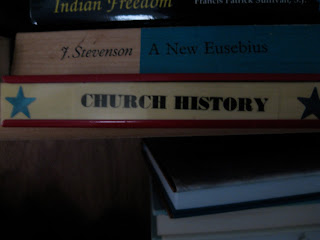 End of an Era...for Some
End of an Era...for SomeNow the truth is, the word "convent" probably brings images of the antique cloistered communities in old Europe, nestled away in the far reaches of Bergundian, Swabian, or Florentine valleys; giant stone walls from the time of St. Francis or his pious successors guarding the solemnly garbed sisters against the outside world. But today, I speak of something quite different. Admittedly, our visit today is not really a "convent" per se, but a home for Catholic women, some of them belonging to orders. This was a serendipitous find, partly because like many of my other travels and explorations, it came up as a total surprise. Two different friends and colleagues had been in touch about this project, and I'd been working with one of them that very morning, in the cold winter weather, on another project. We'd just had a big snow, and had been shoveling. But I also had a meeting with this friend to pick up some book boxes. After the delivery, I agreed to help with this project.
 When I arrived with him at this other project, I discovered, to my surprise and delight, that the other friend was waiting--she'd been in charge of this move. The unassuming, though large, structure on a quiet street in Chicago, was the community home of a catholic women's community organization. Perhaps because of finances, perhaps because of dwindling numbers, or perhaps because of many inter-working causes, the owners of the home--some portion of the Catholic Church--had decided to consolidate, and move the inhabitants into a nearby Catholic institution, and sell this building. And so, I'd ended up as part of the moving crew of the books from the home's library. It was a fine library collection, plump with theological materials and "Catholicana" of varying brands. There were books all over the place, such as on this little ledge above; but there were shelves dedicated to a real "library space" on the top floor, which is where the majority of the collection was housed.
When I arrived with him at this other project, I discovered, to my surprise and delight, that the other friend was waiting--she'd been in charge of this move. The unassuming, though large, structure on a quiet street in Chicago, was the community home of a catholic women's community organization. Perhaps because of finances, perhaps because of dwindling numbers, or perhaps because of many inter-working causes, the owners of the home--some portion of the Catholic Church--had decided to consolidate, and move the inhabitants into a nearby Catholic institution, and sell this building. And so, I'd ended up as part of the moving crew of the books from the home's library. It was a fine library collection, plump with theological materials and "Catholicana" of varying brands. There were books all over the place, such as on this little ledge above; but there were shelves dedicated to a real "library space" on the top floor, which is where the majority of the collection was housed.Intriguing religious images adorned the walls of the old house, including this "rabbinic" looking Last Supper. Below, we find an image of Saint Magdalena Zofia Barat. This image has her name written in the Slavic form, likely Polish, with the title "sw." or "swety" ("saint") before her name. Saint Magdalena Zofia Barat was born in France in 1779. She was one of the primary founders of the Society of the Sacred Heart in 1800. At her death in 1865, she'd have a following of more than 3,500 practitioners in nearly 100 religious houses around the world.
Above is an image of empty book cases in one of the hallways of the house. All the books here were taken away, moved to another location.
Above and below are images of some of the subject plates, which once directed visitors and patrons of the mini-library to their topics of choice.
Some of the books remaining on the shelves can still be seen here. Below, packing up the remains for Theological Book Network; eventually, many of these books will be redistributed--most likely, overseas...to some new or growing seminary in the developing (or, "2/3s") world.
Looking out the windows...a quiet reminder of another closing chapter of life. Below, Melody Layton McMahon, Director of the Bechtold Library at the Catholic Theological Union, pausing to display a carved book-end of a pious monk-reader.
Ends and transitions are all part of life and this world. And there are likely to be many surprises, depending on where you look. I spent a good part of the day helping to carry boxes and shovel snow. Yet, once again, like some of our other adventures in book-land, we are capturing a moment of passing history. When I was leaving, I passed by these two items hanging on the wall (below): a mystical image of Christ in the most saintly pose and a little needlepoint of a grazing gazelle with the word "Thanks" above it. In some ways, seeing these two images was like experiencing a peaceful "sending off." Something like "so long...and thanks for visiting and remembering us!" I'm sure someone will remember this place. Another transition. Onto other pastures. I'm glad that I was around this day to help carry boxes and document the end of this library's chapter. Now a few more people will know the story of a once-lovely mini religious library.












The reason there is a portrait of Madeleine Sophie Barat is because this house did belong to her order. The sisters have moved to other cities or other living situations in Chicago. Thanks for helping with that project!
ReplyDelete